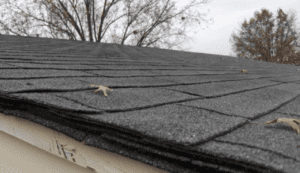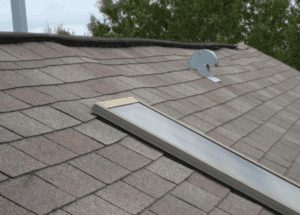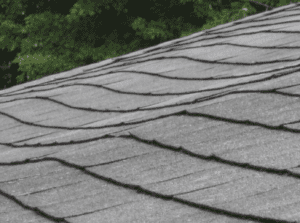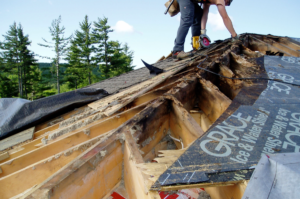What’s a roof-over?

In the roofing industry, a common cost-cutting practice is to install a layer of new asphalt shingles over an old roof. This practice is called a roof-over and it costs less because there is no removal or disposal of the old roof. It also avoids having to install new roof sheathing and waterproof flashings, thus saving even more money.
Sadly, shingling over an existing roof is still permissible by the building codes in most areas of the country and many roofers consider it a common industry practice.
To the average unsuspecting homeowner, the finished shingle-over roof may look OK, and the price will certainly be enticing. But any experienced roofer can tell without even stepping on the roof that it has multiple layers of older material underneath. The surface of the completed roof may appear good, but the problems can arise in areas that cannot be seen.
Most responsible, professional roofers are aware of the shortcomings of this practice and will not even provide the option to their customers. As a homeowner, if you are offered this, you should know the risks. Skipping the tear-off stage, means you will not really get a new roof.
Only consider doing so if the risks are fully disclosed and it is the only thing you can afford.
Please note, the intention of this article is not to police the roofing industry, but rather to educate the homeowner on how to make a good decision for themselves when it comes to roofing options.
New roof work scope
During a quality roof replacement, a good roofing crew will close windows and skylights, then install protection in the attic and around landscaping areas to prevent debris from fouling or damaging those areas. Then they will remove the old layers of shingles and roof paper and haul everything off-site to be disposed. Stripping the roof down to decking, allows an accurate visual inspection and assessment of the condition of the wood structure under the shingles. Without removing the surface material, it is impossible to really tell what’s going on underneath, especially if there is no attic area.
Structural condition
Most roofs being replaced will be more than 20-30 years old, so many will have decking (sheathing) issues somewhere. Removing the old roof allows visual assessment of the structure and sheathing. Exposing the wood framing and sheathing will reveal any dry rot, or defective framing or ventilation all of which should be repaired before the new roof goes on.
Flashing is important
Flashing is a critical part of any roof. This is the material used to provide waterproofing protection at roof/wall junctions and intersections. All penetrations through the roof or places where the roof meets walls, or changes directions and at edges must have properly installed flashing to guarantee water tightness.
Most flashing material used on homes is made of galvanized sheet metal which has a lifespan of about 25-30 years. Which happens to also be the average life expectancy of the roofing. Since proper flashing can only be installed on the first layer of roofing. Subsequent layers of roofing will be relying on old flashing that is beyond it’s expected life to provide key waterproofing functions. The only way to resolve this problem is by using lots of caulking. Unfortunately, caulking has an even shorter lifespan than metal flashing and tends to dry out, crack and become non-functional after a fairly short exposure to the elements. All bad news.
Over-weight roof

Extra layers of roofing mean extra weight. Older homes built before the 1950’s commonly used 2×4 rafter/trusses spaced 24” apart. The decking consisted of “skip” sheathing which referred to 1×4 boards laid across the rafters with 4” spaces or “skips” between the boards. This worked great for wood shingle or shake roofs as it improved durability by allowing more air to circulate under the roof material. 2×4 rafters, skip sheathing and wood shingles make a very lightweight roofing system.
Then asphalt shingles were introduced. Asphalt shingle roofing is about twice as heavy as dry wood shakes. Asphalt shingle roofing also needs a solid sub-surface so the “skips” in the structure were either filled-in or a layer of plywood was applied over the top. This added more weight. Now if you add another layer of asphalt shingle roofing material over the top, you have likely exceeded the original design specs for the roof structure by about 100%. These older 2×4 rafters often don’t have the strength to support extra layers of shingles. You will see this plainly as sagging areas either along the ridge or on the main roof surfaces.
Cost /value

Removing, or demolishing existing roof materials isn’t cheap. It takes time and is hard, dangerous work. This danger means roofers have one of the highest rates for workers compensation insurance in the industry. Old roof removal or “tear-off” adds $100 to $200 per square (a square is 10’x10’ or 100 square feet) to the cost of a new roof. On a 20-square roof that would be $2,000 to $4,000.
Skipping the tear-off stage will of course save money, but homeowners need to know that in doing so, they will not really get a new roof. Roofs tend to fail and leak primarily at the flashing areas and not on the large roof planes. Failing to replace the flashings means the roof is more likely to leak at those areas.
Warranties
For all the reasons noted above, skipping the removal of the old roof should never be an option. Respectable roofing companies make tear off mandatory and most material manufacturer warranties like The GAF Master Elite certification and Golden Pledge warranty would be voided if the new roof isn’t installed onto decking. CertainTeed’s Five Star warranty—good against defects for 50 years—requires that the shingles be installed on “a clean, dry deck.”
Start Fresh

Starting fresh means the old roof is completely removed. Your new roof can then be installed on wood framing that is sound and rot free. A new roof will come with all the new industry advanced elements, such as breathable membranes and longer lasting flashing that are integrated into a system that enables products like a 50-year shingle to perform at their best.
Installing a second layer roofing denies the homeowner of these benefits and advancements. Ice-and-water shielding, drip edge flashing and new and better ventilation systems are not incorporated into a roof-over. A new roof, properly installed, should be a long-term asset and a real attraction to potential or future buyers. An asset that can be incorporated into the asking price.
Summary
Homeowners need to know their risks in order to make good choices, and for reputable roofers, explaining tear-off and price differences is about providing the best possible service for their customers.








